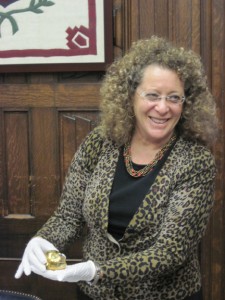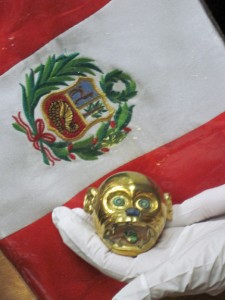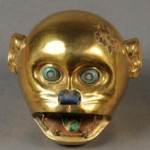 At a ceremony today in Washington, D.C., the History Museum repatriated to the country of Peru an artifact that came from a likely illegal archaeological dig in that country’s Sipan region in the late 1980s. There’s more on that artifact and its history here, but we thought the words spoken by museum Director Frances Levine at the ceremony bore sharing. In situations such as these, the parties can be contentious or they can be diplomatic. We’re proud of Dr. Levine for choosing the latter route.
At a ceremony today in Washington, D.C., the History Museum repatriated to the country of Peru an artifact that came from a likely illegal archaeological dig in that country’s Sipan region in the late 1980s. There’s more on that artifact and its history here, but we thought the words spoken by museum Director Frances Levine at the ceremony bore sharing. In situations such as these, the parties can be contentious or they can be diplomatic. We’re proud of Dr. Levine for choosing the latter route.
Her comments:
Muchisimas gracias a todos por la oportunidad de estar aquí con ustedes en este día tan historico y importante.
As a museum director and an archaeologist by training, I am pleased to be part of this ceremony to return this magnificent Moche treasure to the people of Peru.
In New Mexico we understand the process and the importance of repatriation. We too have seen artifacts taken long ago from our ancient archaeological sites and from Pueblo Indian communities returned to the cultures from which they came. And we are grateful for their return.
While the Moche monkey head was appreciated by thousands of visitors when it was on display in the Palace of the Governors, I believe it can more fully tell its story when it is placed in the context of the culture and environment where it was created. I believe that this treasure has its own stories and legends to tell to the people of Peru, and that it too will be enjoyed by thousands of your citizens when it returns to Peru.
The piece was collected at a time when the world was just becoming aware of the reasons that such contexts matter. Its return symbolizes the commitment of New Mexico’s museums to the recognition of many people’s stories that have told over many centuries.
In the last few decades, museums have changed how they regard artifacts such as these. At one time, it was important to bring the world to our visitors, and so we collected from many parts of the world and assembled those artifacts into exhibitions that attempted to tell stories to people who might never travel to these often exotic places. Today, we are choosing to focus on the stories that took place in our own patria, and on our own tierra, and to do so, in part, with artifacts and the oral histories, las memorias, of our own patrimony.
 Since the New Mexico History Museum opened in 2009, joining the Palace of the Governors, we’ve charted a place for ourselves on the international stage of museums. We worked closely with Spain to host the U.S. premiere of –El Hilo de la Memoria-–The Threads of Memory exhibition in Santa Fe in 2010. We are working now with Mexico on a joint exhibition about santero artistic traditions that united the beliefs and cultures of our two countries. Perhaps, we will also find ourselves working with Peru to examine the colonial conditions of our shared histories, both colonies settled by pobladores who came to the New World from Spain.
Since the New Mexico History Museum opened in 2009, joining the Palace of the Governors, we’ve charted a place for ourselves on the international stage of museums. We worked closely with Spain to host the U.S. premiere of –El Hilo de la Memoria-–The Threads of Memory exhibition in Santa Fe in 2010. We are working now with Mexico on a joint exhibition about santero artistic traditions that united the beliefs and cultures of our two countries. Perhaps, we will also find ourselves working with Peru to examine the colonial conditions of our shared histories, both colonies settled by pobladores who came to the New World from Spain.
Our museum is proud of its reputation for integrity, cultural sensitivity and cooperation, and with those qualities in mind our museum collections committees and the museums’ Board of Regents voted unanimously to repatriate this precious artifact. As we place this national treasure in your hands, we very much look forward to a future in which we will work toward even more opportunities for collaboration. Esperamos continuar trabjando juntos en el futuro. Gracias.

